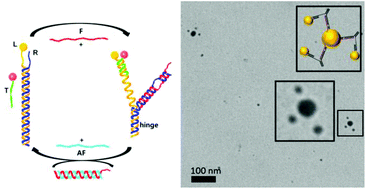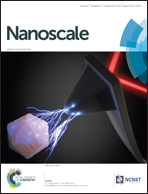DNA nano-carrier for repeatable capture and release of biomolecules†
Abstract
DNA can be manipulated to design nano-machines through specific sequence recognition. We report a switchable DNA carrier for repeatable capture and release of a single stranded DNA. The activity of the carrier was regulated by the interactions among a double-stranded actuator, single stranded target, fuel, and anti-fuel DNA strands. Inosine was used to maintain a stable triple-stranded complex when the actuator's conformation was switched between open (capture) and closed (release) configurations. Time lapse fluorescence measurements show repeatable capture and release of target strands. TEM images also show visible capture of target DNA strands when gold nanoparticles were attached to the DNA carrier and the target DNA strand. The carrier activity was controlled by length of toeholds, number of mismatches, and inosine substitutions. Significantly, unlike in previously published work that reported the devices functioned only when there is a perfect match between the interacting DNA strands, the present device works only when there are mismatches in the fuel strand and the best performance is achieved for 1–3 mismatches. The device was used to successfully capture and release gold nanoparticles when linked to the target single-stranded DNA. In general, this type of devices can be used for transport and delivery of theranostic molecules.


 Please wait while we load your content...
Please wait while we load your content...